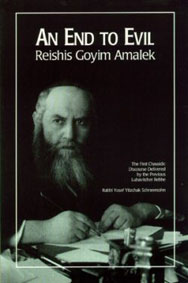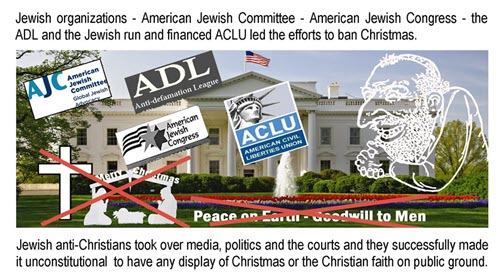 A book which is an example of the deep-seated hatred of Gentiles. It is roughly translated as the “destruction of the evil Gentiles”
A book which is an example of the deep-seated hatred of Gentiles. It is roughly translated as the “destruction of the evil Gentiles”
The following is an excerpt from L. A. Rollins’ book review of Why The Jews? The Reason For Antisemitism by Dennis Prager and Joseph Telushkin. This review contains a wealth of useful information. –Dave Cooper
.
Why The Goyim?
“Jews have suffered, and Christians have suffered. Mankind has suffered. There is no group with a monopoly on suffering, and no human beings which have experienced hate and hostility more than any other. I must say, however, that it is my impression that Jewish history has been taught with a whine and a whimper rather than with a straight-forward acknowledgment that man practices his inhumanity on his fellow human beings …”
— Rabbi Richard E. Singer, Highland Park, Illinois, Lakeside Congregation. Quoted by Alfred Lilienthal, The Zionist Connection. (New York: Dodd, Mead, 1978), p. 401.
In Why the Jews?, Dennis Prager and Joseph Telushkin perform a disingenuous duet of whining and whimpering. The basic premise of the book, which I dispute, is that (p. 17) “Hatred of the Jew has been humanity’s great hatred. While hatred of other groups has always existed, no hatred has been as universal, as deep or as permanent as antisemitism.”
But all of Prager and Telushkins’ arguments in support of their assertion of the “uniqueness” of Jew-hatred are rendered at best inconclusive by a fundamental defect in their discussion. This defect is their failure to acknowledge the reality of another form of hatred that has been as universal, deep and permanent as Jew-hatred. I’m talking about Goy-hatred.
Space limitations preclude my documenting the phenomenon of Goy-hatred in the detail that I would like to. So interested readers are referred to my book A History of Anti-Gentilism, forthcoming from Random House — when Hell freezes over. But right now I will quote just one piece of Jewish testimony concerning Goy-hatred. Writing under the name “Avner,” a former member of LEHI, also known as the Stern Gang, a Jewish terrorist organization in Mandatory Palestine, described his joining the group:
Tsfoni handed us each a heavy revolver and said in a harsh voice which immediately acquainted us with the spirit of the adventure we were embarking on:
“No pity for the Goys.”
I experienced an inner surge of emotion.
It was years since I had heard this word. It was never used in the kibboutz because there was no place for it in Marxist terminology. For the European Jew, the term is not necessarily one of abuse. It is the way in which it is said which gives it its character. For the Lehi, on the other hand, an Englishman would always be a filthy Goy, who could be killed for this reason alone, but if one in particular was necessary — the Polish pogrom and the Hitler camps. Later, I saw this biological hatred appear in the course of operations, as in the case of the eighteen-year-old Sabra who, after having fired a burst of submachinegun fire point-blank at a policeman, instead of running away, lingered a long while battering the already cooling body with the butt of his weapon. (Memoirs of an Assassin: Confessions of a Stern Gang Killer [New York: Thomas Yoseloff, 1959], p. 78.)
In the course of this review, I will present some additional evidence of the existence of Goy-hatred throughout Jewish history.
Their failure to acknowledge the reality of Goy-hatred is not the only defect in Prager and Telushkins’ discussion of the alleged uniqueness of Jew-hatred. Another defect is their penchant for magnifying the extent of Jew-hatred by promiscuously labeling as Jew-hatred (or “antisemitism”) any opinion concerning Jews that they find troublesome, and by endorsing false or exaggerated Jewish accusations against the Goyim.
As an example of their promiscuous use of the “antisemitism” label, consider this statement (p. 17), intended to illustrate the allegedly unique nature of Jew-hatred: “Jews who live in non-Jewish societies have been accused of having dual loyalties, and Jews who live in the Jewish state have been condemned as ‘racists.’ ” But inasmuch as it is true that some Jews who live in “non-Jewish” societies do have dual loyalties, and some Jews who live in the Jewish state are racists, saying so does not necessarily indicate Jew-hatred.
[…]
The main point of Why the Jews? is to present Prager and Telushkins’ explanation of Jew-hatred. They reject various explanations that have been proposed, including (p. 20) “economic factors, the need for scapegoats, ethnic hatred, xenophobia, resentment of Jewish affluence and professional success, and religious bigotry.” They assert that none of these things provides an ultimate or universal explanation of Jew-hatred. And they assume there must be such an ultimate, universal explanation. Why must there be? They say (p. 21): “Antisemitism has existed too long and in too many disparate cultures to ignore the problem of ultimate cause and/or to claim that new or indigenous factors are responsible every time it erupts.” But to deny that there is any ultimate, universal cause of Jew-hatred is not necessarily to imply that “new and indigenous factors are responsible every time it erupts.” To prove their point, Prager and Telushkin must prove that new and indigenous factors are never responsible for Jew- hatred. This they have not done.
[…]
In Chapter Fourteen, Prager and Telushkin ask the musical question, “What Is to Be Done?” Or, in other words (p. 179): “What, if anything can Jews do to eradicate, diminish, or at the very least, individually avoid antisemitism?”
They say (p. 182) that assimilation, defined as “ceasing to be a Jew,” is “… a rational and viable way to escape antisemitism for individuals, not to the Jewish people as a whole. Many Jews will never assimilate, which alone invalidates assimilation as a solution to antisemitism.”
Thus, Prager and Telushkin are looking for a total (final?) “solution to antisemitism.” Furthermore (pp. 181-82): “A solution to antisemitism must by definition include the survival of Jewry, just as a solution to an illness must by definition include the survival of the patient. We seek solutions to antisemitism which enable Jews to live as Jews.” But if, as they assert elsewhere in the book, Jew-hatred is an inevitable response to Judaism, then how can there be any total “solution to antisemitism” which enables Jews to live as Jews? The only possibility that comes to mind is the elimination of all “non-Jews,” one way or another.
Prager and Telushkin do not, in fact, advocate such a solution. Instead, after showing that some other solutions (Zionism, seeking converts, fighting “antisemitism” a la the ADL) are not total solutions, they announce (p. 191) the following “solution to anti- semitism”: “… if the goal is to put an end to antisemitism, then Jews must also attempt to influence the moral values of non-Jews so that no aspect of Judaism any longer threatens the non-Jews’ values.” What does this mean in practical terms? Here’s the closet that they come to answering this question (ibid.): “Jews must therefore resume their original task of spreading ethical monotheism… This means in essence that the Jews must make the world aware of two basic principles: ethics need God, and God’s major demand is ethics.”
But Prager and Telushkin don’t tell us how they are going to get the world to accept “ethical monotheism.” Furthermore, they don’t clearly explain how such acceptance of “ethical monotheism” will necessarily end “antisemitism.” After all, there have been many Christian and Moslem “ethical monotheists” who nevertheless, in Prager and Telushkin’s opinion, have been “antisemites.” I suggest the Prager and Telushkin’s “solution to antisemitism” is as illusory as their “God” and his commandments.
If a “solution to antisemitism” is in fact possible, its discovery will require a more honest consideration of the problem than Prager and Telushkin have given it. This means, among other things, that the problem of Jew-hatred cannot be divorced from the problems of Goy-hatred. If there is to be a solution to the former problem, there must be a solution to the latter problem as well. So rather than devoting themselves exclusively to whining and whimpering “Why the Jews?,” I suggest that Prager and Telushkin finally begin to ask themselves: “Why the Goyim?”
The complete review can be found at the Institute for Historical Review:
http://www.ihr.org/jhr/v05/v05p375_Rollins.html



